Yilin Wu
LargeMvC-Net: Anchor-based Deep Unfolding Network for Large-scale Multi-view Clustering
Jul 28, 2025Abstract:Deep anchor-based multi-view clustering methods enhance the scalability of neural networks by utilizing representative anchors to reduce the computational complexity of large-scale clustering. Despite their scalability advantages, existing approaches often incorporate anchor structures in a heuristic or task-agnostic manner, either through post-hoc graph construction or as auxiliary components for message passing. Such designs overlook the core structural demands of anchor-based clustering, neglecting key optimization principles. To bridge this gap, we revisit the underlying optimization problem of large-scale anchor-based multi-view clustering and unfold its iterative solution into a novel deep network architecture, termed LargeMvC-Net. The proposed model decomposes the anchor-based clustering process into three modules: RepresentModule, NoiseModule, and AnchorModule, corresponding to representation learning, noise suppression, and anchor indicator estimation. Each module is derived by unfolding a step of the original optimization procedure into a dedicated network component, providing structural clarity and optimization traceability. In addition, an unsupervised reconstruction loss aligns each view with the anchor-induced latent space, encouraging consistent clustering structures across views. Extensive experiments on several large-scale multi-view benchmarks show that LargeMvC-Net consistently outperforms state-of-the-art methods in terms of both effectiveness and scalability.
From Foresight to Forethought: VLM-In-the-Loop Policy Steering via Latent Alignment
Feb 03, 2025Abstract:While generative robot policies have demonstrated significant potential in learning complex, multimodal behaviors from demonstrations, they still exhibit diverse failures at deployment-time. Policy steering offers an elegant solution to reducing the chance of failure by using an external verifier to select from low-level actions proposed by an imperfect generative policy. Here, one might hope to use a Vision Language Model (VLM) as a verifier, leveraging its open-world reasoning capabilities. However, off-the-shelf VLMs struggle to understand the consequences of low-level robot actions as they are represented fundamentally differently than the text and images the VLM was trained on. In response, we propose FOREWARN, a novel framework to unlock the potential of VLMs as open-vocabulary verifiers for runtime policy steering. Our key idea is to decouple the VLM's burden of predicting action outcomes (foresight) from evaluation (forethought). For foresight, we leverage a latent world model to imagine future latent states given diverse low-level action plans. For forethought, we align the VLM with these predicted latent states to reason about the consequences of actions in its native representation--natural language--and effectively filter proposed plans. We validate our framework across diverse robotic manipulation tasks, demonstrating its ability to bridge representational gaps and provide robust, generalizable policy steering.
Maximizing Alignment with Minimal Feedback: Efficiently Learning Rewards for Visuomotor Robot Policy Alignment
Dec 06, 2024
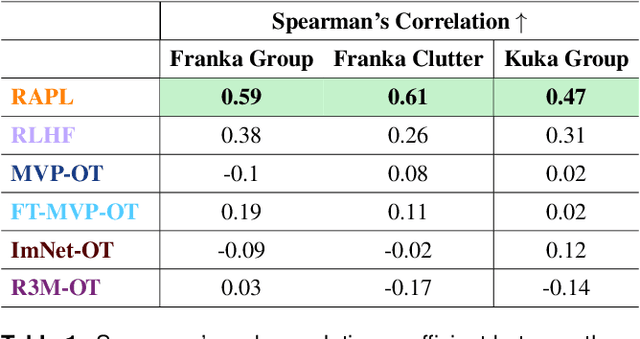

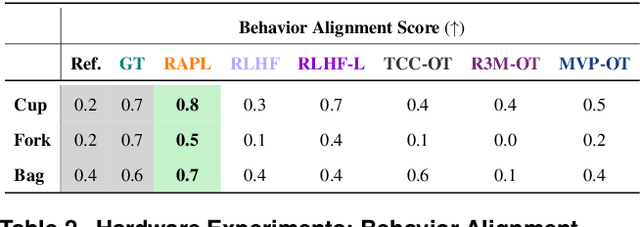
Abstract:Visuomotor robot policies, increasingly pre-trained on large-scale datasets, promise significant advancements across robotics domains. However, aligning these policies with end-user preferences remains a challenge, particularly when the preferences are hard to specify. While reinforcement learning from human feedback (RLHF) has become the predominant mechanism for alignment in non-embodied domains like large language models, it has not seen the same success in aligning visuomotor policies due to the prohibitive amount of human feedback required to learn visual reward functions. To address this limitation, we propose Representation-Aligned Preference-based Learning (RAPL), an observation-only method for learning visual rewards from significantly less human preference feedback. Unlike traditional RLHF, RAPL focuses human feedback on fine-tuning pre-trained vision encoders to align with the end-user's visual representation and then constructs a dense visual reward via feature matching in this aligned representation space. We first validate RAPL through simulation experiments in the X-Magical benchmark and Franka Panda robotic manipulation, demonstrating that it can learn rewards aligned with human preferences, more efficiently uses preference data, and generalizes across robot embodiments. Finally, our hardware experiments align pre-trained Diffusion Policies for three object manipulation tasks. We find that RAPL can fine-tune these policies with 5x less real human preference data, taking the first step towards minimizing human feedback while maximizing visuomotor robot policy alignment.
FinRobot: AI Agent for Equity Research and Valuation with Large Language Models
Nov 13, 2024



Abstract:As financial markets grow increasingly complex, there is a rising need for automated tools that can effectively assist human analysts in equity research, particularly within sell-side research. While Generative AI (GenAI) has attracted significant attention in this field, existing AI solutions often fall short due to their narrow focus on technical factors and limited capacity for discretionary judgment. These limitations hinder their ability to adapt to new data in real-time and accurately assess risks, which diminishes their practical value for investors. This paper presents FinRobot, the first AI agent framework specifically designed for equity research. FinRobot employs a multi-agent Chain of Thought (CoT) system, integrating both quantitative and qualitative analyses to emulate the comprehensive reasoning of a human analyst. The system is structured around three specialized agents: the Data-CoT Agent, which aggregates diverse data sources for robust financial integration; the Concept-CoT Agent, which mimics an analysts reasoning to generate actionable insights; and the Thesis-CoT Agent, which synthesizes these insights into a coherent investment thesis and report. FinRobot provides thorough company analysis supported by precise numerical data, industry-appropriate valuation metrics, and realistic risk assessments. Its dynamically updatable data pipeline ensures that research remains timely and relevant, adapting seamlessly to new financial information. Unlike existing automated research tools, such as CapitalCube and Wright Reports, FinRobot delivers insights comparable to those produced by major brokerage firms and fundamental research vendors. We open-source FinRobot at \url{https://github. com/AI4Finance-Foundation/FinRobot}.
HACMan++: Spatially-Grounded Motion Primitives for Manipulation
Jul 11, 2024



Abstract:Although end-to-end robot learning has shown some success for robot manipulation, the learned policies are often not sufficiently robust to variations in object pose or geometry. To improve the policy generalization, we introduce spatially-grounded parameterized motion primitives in our method HACMan++. Specifically, we propose an action representation consisting of three components: what primitive type (such as grasp or push) to execute, where the primitive will be grounded (e.g. where the gripper will make contact with the world), and how the primitive motion is executed, such as parameters specifying the push direction or grasp orientation. These three components define a novel discrete-continuous action space for reinforcement learning. Our framework enables robot agents to learn to chain diverse motion primitives together and select appropriate primitive parameters to complete long-horizon manipulation tasks. By grounding the primitives on a spatial location in the environment, our method is able to effectively generalize across object shape and pose variations. Our approach significantly outperforms existing methods, particularly in complex scenarios demanding both high-level sequential reasoning and object generalization. With zero-shot sim-to-real transfer, our policy succeeds in challenging real-world manipulation tasks, with generalization to unseen objects. Videos can be found on the project website: https://sgmp-rss2024.github.io.
DROID: A Large-Scale In-The-Wild Robot Manipulation Dataset
Mar 19, 2024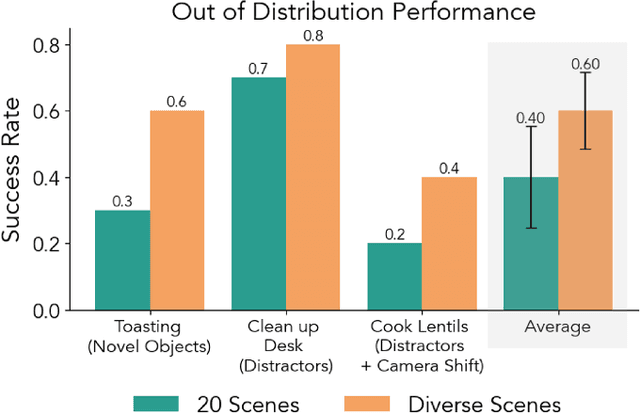
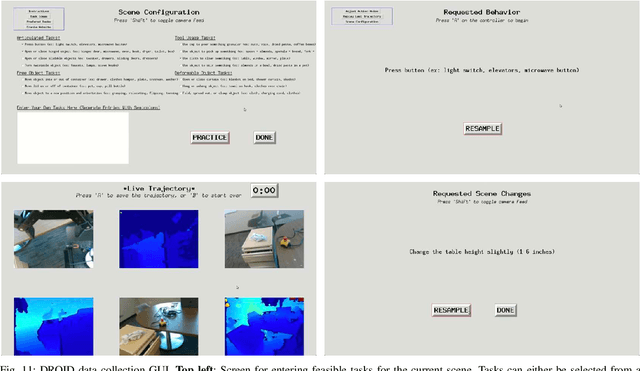
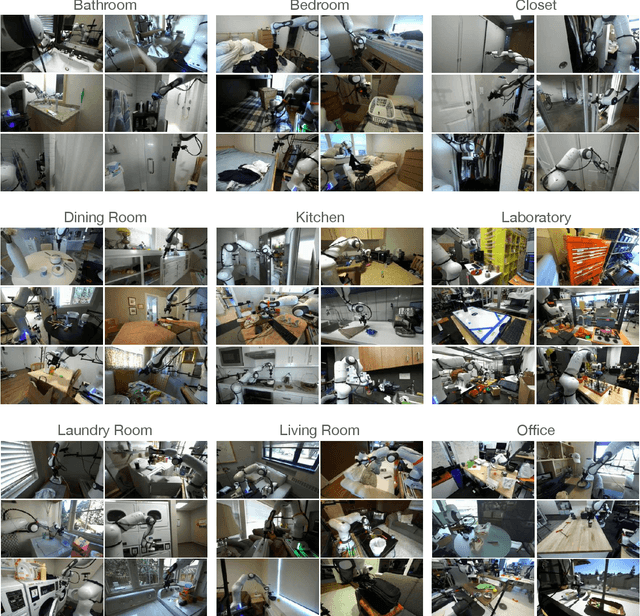
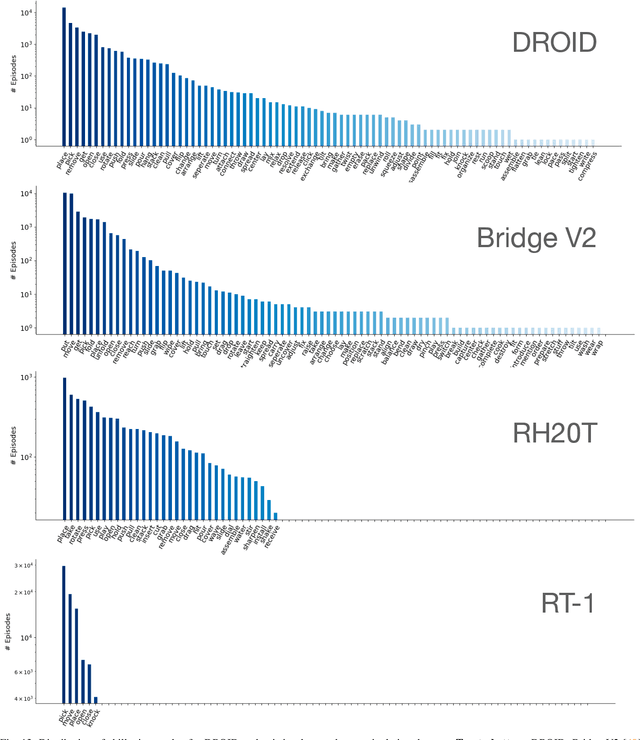
Abstract:The creation of large, diverse, high-quality robot manipulation datasets is an important stepping stone on the path toward more capable and robust robotic manipulation policies. However, creating such datasets is challenging: collecting robot manipulation data in diverse environments poses logistical and safety challenges and requires substantial investments in hardware and human labour. As a result, even the most general robot manipulation policies today are mostly trained on data collected in a small number of environments with limited scene and task diversity. In this work, we introduce DROID (Distributed Robot Interaction Dataset), a diverse robot manipulation dataset with 76k demonstration trajectories or 350 hours of interaction data, collected across 564 scenes and 84 tasks by 50 data collectors in North America, Asia, and Europe over the course of 12 months. We demonstrate that training with DROID leads to policies with higher performance and improved generalization ability. We open source the full dataset, policy learning code, and a detailed guide for reproducing our robot hardware setup.
Stabilize to Act: Learning to Coordinate for Bimanual Manipulation
Sep 03, 2023Abstract:Key to rich, dexterous manipulation in the real world is the ability to coordinate control across two hands. However, while the promise afforded by bimanual robotic systems is immense, constructing control policies for dual arm autonomous systems brings inherent difficulties. One such difficulty is the high-dimensionality of the bimanual action space, which adds complexity to both model-based and data-driven methods. We counteract this challenge by drawing inspiration from humans to propose a novel role assignment framework: a stabilizing arm holds an object in place to simplify the environment while an acting arm executes the task. We instantiate this framework with BimanUal Dexterity from Stabilization (BUDS), which uses a learned restabilizing classifier to alternate between updating a learned stabilization position to keep the environment unchanged, and accomplishing the task with an acting policy learned from demonstrations. We evaluate BUDS on four bimanual tasks of varying complexities on real-world robots, such as zipping jackets and cutting vegetables. Given only 20 demonstrations, BUDS achieves 76.9% task success across our task suite, and generalizes to out-of-distribution objects within a class with a 52.7% success rate. BUDS is 56.0% more successful than an unstructured baseline that instead learns a BC stabilizing policy due to the precision required of these complex tasks. Supplementary material and videos can be found at https://sites.google.com/view/stabilizetoact .
Learning Bimanual Scooping Policies for Food Acquisition
Nov 26, 2022Abstract:A robotic feeding system must be able to acquire a variety of foods. Prior bite acquisition works consider single-arm spoon scooping or fork skewering, which do not generalize to foods with complex geometries and deformabilities. For example, when acquiring a group of peas, skewering could smoosh the peas while scooping without a barrier could result in chasing the peas on the plate. In order to acquire foods with such diverse properties, we propose stabilizing food items during scooping using a second arm, for example, by pushing peas against the spoon with a flat surface to prevent dispersion. The added stabilizing arm can lead to new challenges. Critically, this arm should stabilize the food scene without interfering with the acquisition motion, which is especially difficult for easily breakable high-risk food items like tofu. These high-risk foods can break between the pusher and spoon during scooping, which can lead to food waste falling out of the spoon. We propose a general bimanual scooping primitive and an adaptive stabilization strategy that enables successful acquisition of a diverse set of food geometries and physical properties. Our approach, CARBS: Coordinated Acquisition with Reactive Bimanual Scooping, learns to stabilize without impeding task progress by identifying high-risk foods and robustly scooping them using closed-loop visual feedback. We find that CARBS is able to generalize across food shape, size, and deformability and is additionally able to manipulate multiple food items simultaneously. CARBS achieves 87.0% success on scooping rigid foods, which is 25.8% more successful than a single-arm baseline, and reduces food breakage by 16.2% compared to an analytical baseline. Videos can be found at https://sites.google.com/view/bimanualscoop-corl22/home .
In-Mouth Robotic Bite Transfer with Visual and Haptic Sensing
Nov 23, 2022



Abstract:Assistance during eating is essential for those with severe mobility issues or eating risks. However, dependence on traditional human caregivers is linked to malnutrition, weight loss, and low self-esteem. For those who require eating assistance, a semi-autonomous robotic platform can provide independence and a healthier lifestyle. We demonstrate an essential capability of this platform: safe, comfortable, and effective transfer of a bite-sized food item from a utensil directly to the inside of a person's mouth. Our system uses a force-reactive controller to safely accommodate the user's motions throughout the transfer, allowing full reactivity until bite detection then reducing reactivity in the direction of exit. Additionally, we introduce a novel dexterous wrist-like end effector capable of small, unimposing movements to reduce user discomfort. We conduct a user study with 11 participants covering 8 diverse food categories to evaluate our system end-to-end, and we find that users strongly prefer our method to a wide range of baselines. Appendices and videos are available at our website: https://tinyurl.com/btICRA.
Solving Compositional Reinforcement Learning Problems via Task Reduction
Mar 19, 2021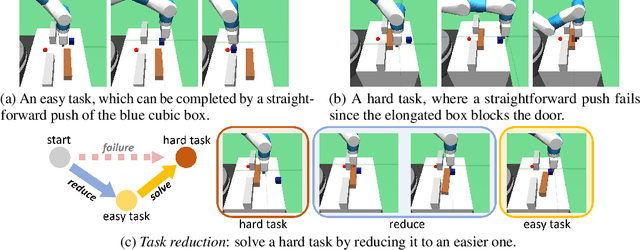


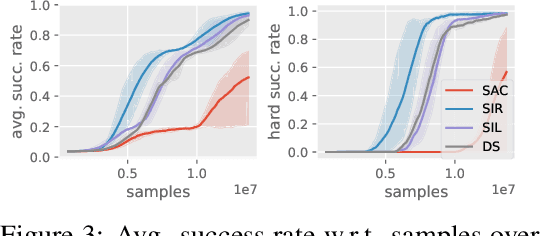
Abstract:We propose a novel learning paradigm, Self-Imitation via Reduction (SIR), for solving compositional reinforcement learning problems. SIR is based on two core ideas: task reduction and self-imitation. Task reduction tackles a hard-to-solve task by actively reducing it to an easier task whose solution is known by the RL agent. Once the original hard task is successfully solved by task reduction, the agent naturally obtains a self-generated solution trajectory to imitate. By continuously collecting and imitating such demonstrations, the agent is able to progressively expand the solved subspace in the entire task space. Experiment results show that SIR can significantly accelerate and improve learning on a variety of challenging sparse-reward continuous-control problems with compositional structures. Code and videos are available at https://sites.google.com/view/sir-compositional.
 Add to Chrome
Add to Chrome Add to Firefox
Add to Firefox Add to Edge
Add to Edge